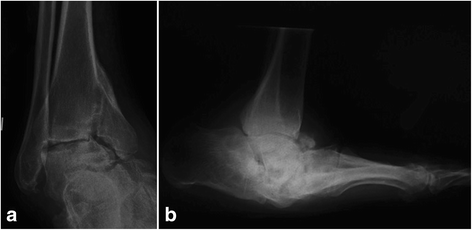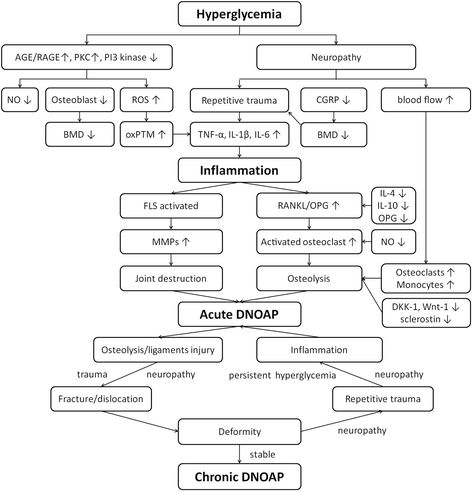Pathogenesis and potential relative risk factors of diabetic neuropathic osteoarthropathy
- PMID: 28969714
- PMCID: PMC5625723
- DOI: 10.1186/s13018-017-0634-8
Pathogenesis and potential relative risk factors of diabetic neuropathic osteoarthropathy
Abstract
Diabetic neuropathic osteoarthropathy (DNOAP) is an uncommon, but with considerable morbidity and mortality rates, complication of diabetes. The real pathogenesis is still unclear. The two popular theories are the neuro-vascular theory and neuro-traumatic theory. Most theories and pathways focused on the uncontrolled inflammations that resulted in the final common pathway, receptor activator of nuclear factor κβ ligand (RANKL)/osteoprotegerin (OPG) axis, for the decreased bone density in DNOAP with an osteoclast and osteoblast imbalance. However, the RANKL/OPG pathway does not explain all the changes, other pathways and factors also play roles. A lot of DNOAP potential relative risk factors were evaluated and reported in the literature, including age, gender, weight, duration and type of diabetes, bone mineral density, peripheral neuropathy and arterial disease, trauma history, and some others. However, most of them are still in debates. Future studies focus on the pathogenesis of DNOAP are still needed, especially for the genetic factors. And, the relationship between DNOAP and those potential relative risk factors are still need to further clarify.
Keywords: Charcot foot; Diabetic neuropathic osteoarthropathy; Pathogenesis; Receptor activator of nuclear factor κβ ligand (RANKL); Risk factor.
Conflict of interest statement
Ethics approval and consent to participate
Not applicable.
Consent for publication
Not applicable.
Competing interests
The authors declare that they have no competing interests.
Publisher’s Note
Springer Nature remains neutral with regard to jurisdictional claims in published maps and institutional affiliations.
Figures


References
Publication types
MeSH terms
Substances
LinkOut - more resources
Full Text Sources
Other Literature Sources
Medical

